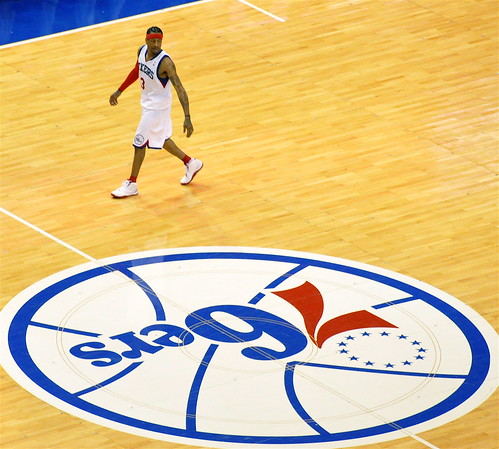Questioning The Answer’s Relevance to the Sport of Tennis
It all started with The Answer. Allen Iverson, the six-foot guard synonymous with Philadelphia basketball, was known for his toughness. Not an I’m-gonna-beat-the-living-shit-out-of-you type of toughness but a toughness that was required of a man his size playing a sport whose predilection for giants is well known.
And with this toughness came injuries and a legacy of playing hurt. Broken bones, dislocations and bruising were par for the course. But, as legend has it, it was a bursitis in his right elbow midway through the 2000–01 season and the compression tubing he chose to wear as a form of in-game treatment that changed basketball and sports branding.
He continued to wear it long after the bursitis had subsided and the sleeve’s medicinal value had dissipated, combining it with a headband, tattoos and cornrows to become one of the most recognisable on-court styles of any era and of any sport.
His style marked the immediate intersection of hip-hop and basketball. He was the anti-Jordan, the game’s antithesis to the perfectly manicured image of the game’s top player.
But sports are conducive to imitation, basketball particularly so. With new players replacing the old and anything from playing styles to game plans up for replication, the new were constantly looking to the past for inspiration. So why wouldn’t style be any different?
NBA players, no longer content with wearing the jersey number or the sneakers of their childhood heroes, were quick to copy. Players were now following AI’s lead—and not just with the injury-inspired form of accessorising—with youngsters like Melo and LeBron and D-Wade entering the league with any combination of jersey number, tattoos, headband and cornrows inspired by The Answer.
The cycle of imitation is perpetual. Kids wearing sleeves today are inspired by a generation of new and younger players—Russell Westbrook, Steph Curry, Kyrie Irving et al—themselves inspired by LeBron, Melo and D-Wade, the original generation who grew up watching and mimicking Allen Iverson’s crossovers.
This imitation has crossed the boundaries of basketball, leaching into other sports. While watching Nick Kyrgios play in the Brisbane International, the Australian Open and the Davis Cup tie with Germany I noticed he had adopted the sleeve as an accessory.
This left me with a few questions. How is a shooting sleeve relevant to tennis? Is it simply an homage to Allen Iverson—the anti-Jordan—or to a more current NBA star like Westbrook or Irving? Elbow injuries are, obviously, not uncommon in tennis. Perhaps he had lateral epicondylitis?
And while Kyrgios's injury history is extensive, these injuries, as seen with today’s sleeved NBA stars, pertain almost entirely to the lower limbs: ankles, knees, hips and the soft tissue surrounding them.
Sporting crossovers are nothing new. They are, however, almost exclusively the domain of Nike brand athletes—designed to generate publicity—and regularly draw on late eighties–early nineties basketball culture (read: the Michael Jordan era). At the 2014 US Open, Roger Federer wore Nike shoes inspired by the Jordan III sneaker. And who could forget Jason Day at the British Open in 2017 rocking heinous white high-top Nikes, inspired by the Jordan I shoe?
But despite Kyrgios himself being a Nike brand athlete, it goes deeper than a simple sporting crossover. He has, in the past, openly stated his love of basketball and of the Boston Celtics.
His refusal to accept the status quo has rubbed against the grain of what is traditionally a conservative sport. A code violation here and a fine there is his status quo. He refuses to hire a coach much to the chagrin of tennis’ aristocracy.
Whether Nick Kyrgios wears a shooting sleeve as an homage to the modern NBA players or Allen Iverson is immaterial, although my preference is for the latter. If Federer is the Jordan of the ATP Tour, a man who’s loved and admired by all, Kyrgios, whether he knows it or not—whether he likes it or not—is the anti-Jordan, tennis’ Answer, always pushing against the establishment. Sometimes to his own detriment.
And who knows? There might be a tennis prodigy somewhere out there who sees a kin—a likeness—in Nick Kyrgios. This kid might swear at himself, he might even break a racquet or two during a match. But he’ll see Kyrgios sending down big serves, a shooting sleeve on his right arm, and he’ll start to wear one, too, all the while knowing very little of the six-foot Philly guard with the dodgy right elbow.
